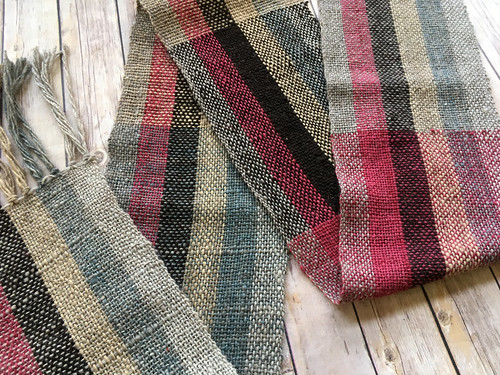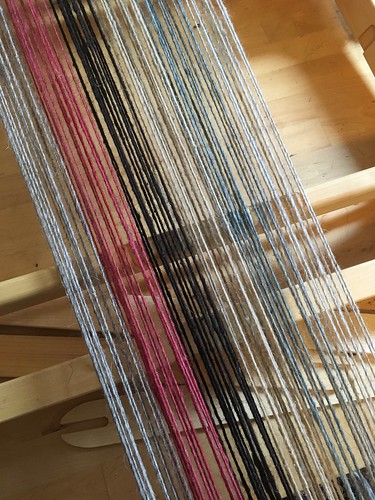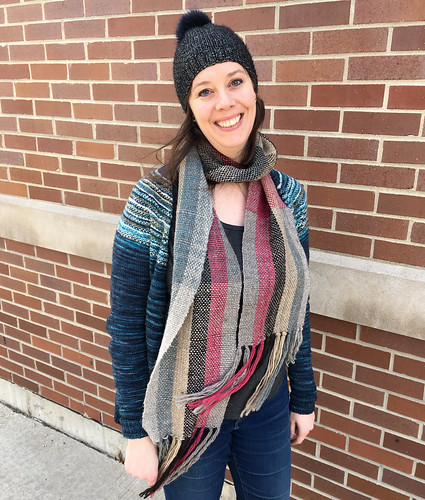Not too long ago, I was sent a lovely box of yarns from Antonio and Molly Manzanares of Shepherd's Lamb, a family-owned and -operated ranch in New Mexico. They raise a flock of Rambouillet and Navajo-Churro sheep to make organic their organic yarns which are processed and spun in the USA, then hand-dyed with low impact or natural dyes on site.
I've never worked with Navajo-Churro before, so I gravitated towards these 6 colors and decided to do a gamp-style woven scarf (for any curious non-weavers out there, here is a great definition of a gamp).
The mix of natural/undyed yarns and naturally dyed colors was really fun to work with, and I have enough yarn left over to each one which I can use in future projects. Now that i know how each color interacts with one another, that will make choosing colors a lot easier (click here to see what colors of Navajo-Churro yarn they currently have available).
I'm guessing that many of my readers have not worked with Navajo-Churro yarn or fiber before, or perhaps never even heard of it. While it's the oldest breed of sheep in North America, Navajo-Churro yarn and fiber isn't something you come across every day (unless you live in the southwest, I'd wager). In fact, this breed was nearly wiped out in the late 1800s and early 1900s by the US government in several attempts to control the Navajo tribe. That chapter of their history is quite sad, but the good news is that, against all of those odds, the Navajo-Churro bloodline has come back from the brink of extinction and these yarns and fibers are still used today by the Navajo people to create their traditional rugs and tapestries.
Navajo-Churro sheep grow a double-coated fleece, so there can be a lot of variation within the fibers, and some Churro I've encountered in the past has been quite coarse (mind you, that hasn't been much!). This yarn was much softer than I was expecting, though anyone who is sensitive to wool may experience a bit of the "prickle factor" when worn close to the skin. Navajo-Churro is known for being lustrous and hard-wearing, as well as incredibly insulating - I have a feeling this scarf will be an excellent choice for a blustery day when I need to double up on all of my winter woolens.
If you've ever wondered what it's like to manage a flock or sheep and manage a working ranch, this short documentary is a fascinating behind-the-scenes peek at the good work Antonio and Molly do:
I've never worked with Navajo-Churro before, so I gravitated towards these 6 colors and decided to do a gamp-style woven scarf (for any curious non-weavers out there, here is a great definition of a gamp).
The mix of natural/undyed yarns and naturally dyed colors was really fun to work with, and I have enough yarn left over to each one which I can use in future projects. Now that i know how each color interacts with one another, that will make choosing colors a lot easier (click here to see what colors of Navajo-Churro yarn they currently have available).
I'm guessing that many of my readers have not worked with Navajo-Churro yarn or fiber before, or perhaps never even heard of it. While it's the oldest breed of sheep in North America, Navajo-Churro yarn and fiber isn't something you come across every day (unless you live in the southwest, I'd wager). In fact, this breed was nearly wiped out in the late 1800s and early 1900s by the US government in several attempts to control the Navajo tribe. That chapter of their history is quite sad, but the good news is that, against all of those odds, the Navajo-Churro bloodline has come back from the brink of extinction and these yarns and fibers are still used today by the Navajo people to create their traditional rugs and tapestries.
Navajo-Churro sheep grow a double-coated fleece, so there can be a lot of variation within the fibers, and some Churro I've encountered in the past has been quite coarse (mind you, that hasn't been much!). This yarn was much softer than I was expecting, though anyone who is sensitive to wool may experience a bit of the "prickle factor" when worn close to the skin. Navajo-Churro is known for being lustrous and hard-wearing, as well as incredibly insulating - I have a feeling this scarf will be an excellent choice for a blustery day when I need to double up on all of my winter woolens.
If you've ever wondered what it's like to manage a flock or sheep and manage a working ranch, this short documentary is a fascinating behind-the-scenes peek at the good work Antonio and Molly do:
I'm excited to share more projects with these lovely yarns soon!




Comments
Post a Comment